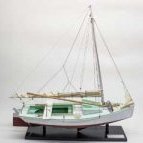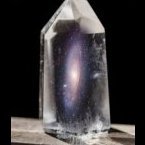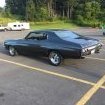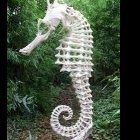-
Posts
355 -
Joined
-
Last visited
Reputation Activity
-
 jhearl got a reaction from dvm27 in Sherline 5400 versus Micro Mark Milling machines
jhearl got a reaction from dvm27 in Sherline 5400 versus Micro Mark Milling machines
I own the Sherline mill so I guess I'll weigh in with a few things to consider. Before I do, though, if you don't already own a metal lathe, I'd recommend making that your first purchase over a mill. You will use it FAR more often. That aside, the main thing to consider between the Sherline and a mini-mill is the size. I sometimes find the Sherline to be a bit small for some things I'd like to do. But I simply don't have room in my shop for a larger mill. The mini-mill offers more travel in all three axes than the Sherline and that could occasionally be useful. At the time I bought my mill, Sherline didn't offer larger and taller columns, but they do now, so that would be something to consider. On the other hand, the large mini-mills are MUCH heavier. The one Micromark sells weighs 110 pounds. There's no chance I could get that up on a cabinet by myself or even get it out of the box! As for power, I have not found any limitation with the Sherline. I'm not trying to hog out 1/4" deep cuts in steel with a half-inch cutter, of course. On the other hand, if I needed some deep cut in steel, I could do it with the Sherline - it just might take a little longer. For ship modeling, it's not likely you're going to need a lot of power and you're probably going to be cutting more brass and wood than you are steel.
One feature I like on the Sherline that I don't believe is available on the MM mill is the ability to rotate the headstock by 90 degrees. I'm not talking about rotating the column - just the headstock. When I make propellers, I use this feature to cut slots in the hub. There's probably a way to do that without rotating the headstock but it seems to me it would require a more difficult setup.
If you decide to go with Sherline, you might want to compare prices at Discount Campus - http://www.discountcampus.com/
I've bought all my Sherline equipment through them because they offer a better price. They are an authorized reseller and, in fact, the equipment winds up getting shipped directly from Sherline in any case.
Another thing to consider is adding the DRO option. I don't have it on my lathe and don't miss it, but I find it VERY useful on the mill. And, by all means, get it with one of the accessory packages. Also consider a rotary table. Very useful for things like steering wheels.
Bottom line, if I had it to do over again, I'd go with the Sherline with larger table and column.
Hope that helps some -
John
-
 jhearl got a reaction from Canute in Sherline 5400 versus Micro Mark Milling machines
jhearl got a reaction from Canute in Sherline 5400 versus Micro Mark Milling machines
I own the Sherline mill so I guess I'll weigh in with a few things to consider. Before I do, though, if you don't already own a metal lathe, I'd recommend making that your first purchase over a mill. You will use it FAR more often. That aside, the main thing to consider between the Sherline and a mini-mill is the size. I sometimes find the Sherline to be a bit small for some things I'd like to do. But I simply don't have room in my shop for a larger mill. The mini-mill offers more travel in all three axes than the Sherline and that could occasionally be useful. At the time I bought my mill, Sherline didn't offer larger and taller columns, but they do now, so that would be something to consider. On the other hand, the large mini-mills are MUCH heavier. The one Micromark sells weighs 110 pounds. There's no chance I could get that up on a cabinet by myself or even get it out of the box! As for power, I have not found any limitation with the Sherline. I'm not trying to hog out 1/4" deep cuts in steel with a half-inch cutter, of course. On the other hand, if I needed some deep cut in steel, I could do it with the Sherline - it just might take a little longer. For ship modeling, it's not likely you're going to need a lot of power and you're probably going to be cutting more brass and wood than you are steel.
One feature I like on the Sherline that I don't believe is available on the MM mill is the ability to rotate the headstock by 90 degrees. I'm not talking about rotating the column - just the headstock. When I make propellers, I use this feature to cut slots in the hub. There's probably a way to do that without rotating the headstock but it seems to me it would require a more difficult setup.
If you decide to go with Sherline, you might want to compare prices at Discount Campus - http://www.discountcampus.com/
I've bought all my Sherline equipment through them because they offer a better price. They are an authorized reseller and, in fact, the equipment winds up getting shipped directly from Sherline in any case.
Another thing to consider is adding the DRO option. I don't have it on my lathe and don't miss it, but I find it VERY useful on the mill. And, by all means, get it with one of the accessory packages. Also consider a rotary table. Very useful for things like steering wheels.
Bottom line, if I had it to do over again, I'd go with the Sherline with larger table and column.
Hope that helps some -
John
-
 jhearl got a reaction from Matrim in Sherline 5400 versus Micro Mark Milling machines
jhearl got a reaction from Matrim in Sherline 5400 versus Micro Mark Milling machines
I own the Sherline mill so I guess I'll weigh in with a few things to consider. Before I do, though, if you don't already own a metal lathe, I'd recommend making that your first purchase over a mill. You will use it FAR more often. That aside, the main thing to consider between the Sherline and a mini-mill is the size. I sometimes find the Sherline to be a bit small for some things I'd like to do. But I simply don't have room in my shop for a larger mill. The mini-mill offers more travel in all three axes than the Sherline and that could occasionally be useful. At the time I bought my mill, Sherline didn't offer larger and taller columns, but they do now, so that would be something to consider. On the other hand, the large mini-mills are MUCH heavier. The one Micromark sells weighs 110 pounds. There's no chance I could get that up on a cabinet by myself or even get it out of the box! As for power, I have not found any limitation with the Sherline. I'm not trying to hog out 1/4" deep cuts in steel with a half-inch cutter, of course. On the other hand, if I needed some deep cut in steel, I could do it with the Sherline - it just might take a little longer. For ship modeling, it's not likely you're going to need a lot of power and you're probably going to be cutting more brass and wood than you are steel.
One feature I like on the Sherline that I don't believe is available on the MM mill is the ability to rotate the headstock by 90 degrees. I'm not talking about rotating the column - just the headstock. When I make propellers, I use this feature to cut slots in the hub. There's probably a way to do that without rotating the headstock but it seems to me it would require a more difficult setup.
If you decide to go with Sherline, you might want to compare prices at Discount Campus - http://www.discountcampus.com/
I've bought all my Sherline equipment through them because they offer a better price. They are an authorized reseller and, in fact, the equipment winds up getting shipped directly from Sherline in any case.
Another thing to consider is adding the DRO option. I don't have it on my lathe and don't miss it, but I find it VERY useful on the mill. And, by all means, get it with one of the accessory packages. Also consider a rotary table. Very useful for things like steering wheels.
Bottom line, if I had it to do over again, I'd go with the Sherline with larger table and column.
Hope that helps some -
John
-
 jhearl got a reaction from coxswain in Sherline 5400 versus Micro Mark Milling machines
jhearl got a reaction from coxswain in Sherline 5400 versus Micro Mark Milling machines
I own the Sherline mill so I guess I'll weigh in with a few things to consider. Before I do, though, if you don't already own a metal lathe, I'd recommend making that your first purchase over a mill. You will use it FAR more often. That aside, the main thing to consider between the Sherline and a mini-mill is the size. I sometimes find the Sherline to be a bit small for some things I'd like to do. But I simply don't have room in my shop for a larger mill. The mini-mill offers more travel in all three axes than the Sherline and that could occasionally be useful. At the time I bought my mill, Sherline didn't offer larger and taller columns, but they do now, so that would be something to consider. On the other hand, the large mini-mills are MUCH heavier. The one Micromark sells weighs 110 pounds. There's no chance I could get that up on a cabinet by myself or even get it out of the box! As for power, I have not found any limitation with the Sherline. I'm not trying to hog out 1/4" deep cuts in steel with a half-inch cutter, of course. On the other hand, if I needed some deep cut in steel, I could do it with the Sherline - it just might take a little longer. For ship modeling, it's not likely you're going to need a lot of power and you're probably going to be cutting more brass and wood than you are steel.
One feature I like on the Sherline that I don't believe is available on the MM mill is the ability to rotate the headstock by 90 degrees. I'm not talking about rotating the column - just the headstock. When I make propellers, I use this feature to cut slots in the hub. There's probably a way to do that without rotating the headstock but it seems to me it would require a more difficult setup.
If you decide to go with Sherline, you might want to compare prices at Discount Campus - http://www.discountcampus.com/
I've bought all my Sherline equipment through them because they offer a better price. They are an authorized reseller and, in fact, the equipment winds up getting shipped directly from Sherline in any case.
Another thing to consider is adding the DRO option. I don't have it on my lathe and don't miss it, but I find it VERY useful on the mill. And, by all means, get it with one of the accessory packages. Also consider a rotary table. Very useful for things like steering wheels.
Bottom line, if I had it to do over again, I'd go with the Sherline with larger table and column.
Hope that helps some -
John
-
 jhearl got a reaction from J11 in Yankee Hero by Jeffrey - FINISHED - BlueJacket Shipcrafters - first build
jhearl got a reaction from J11 in Yankee Hero by Jeffrey - FINISHED - BlueJacket Shipcrafters - first build
I'll tell you how I go about attaching toe rails. I don't pre-bend them or paint them before installing. I start by placing the toe-rail stock at the stem. (You'll probably need to cut an angle on the stock so it fits properly.) While holding it in place with one hand, I drill hole, about an inch or so back from the stem through the toe rail and down into the deck. Then I insert a piece of stiff brass rod through the hole. Now, I move aft to the point where the toe rail needs to curve and repeat the above process. I continue doing that until I've gotten all the way to the stern. You don't need wire every inch or so - just at the points where the toe rail needs to curve.
Here's a picture of this that I did quickly on some scrap (just pretend it's on the edge of a deck):
Note that I have NOT used any glue at this point! It's only the wire holding the toe rail in place. Next, you can carefully raise the toe rail up on the wires. This will give you some space to apply small drops of medium CA.
Push the toe rail back down on the deck and it will be glued in place. Rather than removing the brass wire, I cut it off as close as I can to the top of the toe rail, then sand it down flush. You can apply a small drop of thin CA right on the brass wire and that will anchor it in place. Once painted, the wire will pretty much be invisible.
Hope that helps.
John
-
 jhearl got a reaction from Canute in Letraset 5mm Times New Roman gold, where to find?
jhearl got a reaction from Canute in Letraset 5mm Times New Roman gold, where to find?
You might look at Woodland Scenics. They aren't precisely what you're looking for, but they might work:
https://woodlandscenics.woodlandscenics.com/show/item/DT504
Cheers -
John
-
 jhearl got a reaction from mtaylor in Letraset 5mm Times New Roman gold, where to find?
jhearl got a reaction from mtaylor in Letraset 5mm Times New Roman gold, where to find?
You might look at Woodland Scenics. They aren't precisely what you're looking for, but they might work:
https://woodlandscenics.woodlandscenics.com/show/item/DT504
Cheers -
John
-
 jhearl got a reaction from mugje in Letraset 5mm Times New Roman gold, where to find?
jhearl got a reaction from mugje in Letraset 5mm Times New Roman gold, where to find?
You might look at Woodland Scenics. They aren't precisely what you're looking for, but they might work:
https://woodlandscenics.woodlandscenics.com/show/item/DT504
Cheers -
John
-
 jhearl got a reaction from Dubz in Letraset 5mm Times New Roman gold, where to find?
jhearl got a reaction from Dubz in Letraset 5mm Times New Roman gold, where to find?
You might look at Woodland Scenics. They aren't precisely what you're looking for, but they might work:
https://woodlandscenics.woodlandscenics.com/show/item/DT504
Cheers -
John
-
 jhearl got a reaction from mtaylor in Greetings from Annapolis, MD!
jhearl got a reaction from mtaylor in Greetings from Annapolis, MD!
Since you are so close to the Eastern Shore, you might be interested in attending a one-day model show in Oxford, MD that will be on Saturday, Nov. 9th.
https://oxfordcc.org/model-boat-show/
There will be many very competent modelers there and you would probably enjoy talking with them. The show is free too!
Cheers -
John
-
 jhearl got a reaction from CapnMac82 in Sharpie Schooner by VTHokiEE - FINISHED - Midwest Products - 1:32
jhearl got a reaction from CapnMac82 in Sharpie Schooner by VTHokiEE - FINISHED - Midwest Products - 1:32
There was an interesting discussion about parrels here:
Cheers -
John
-
 jhearl got a reaction from EricWilliamMarshall in Sharpie Schooner by VTHokiEE - FINISHED - Midwest Products - 1:32
jhearl got a reaction from EricWilliamMarshall in Sharpie Schooner by VTHokiEE - FINISHED - Midwest Products - 1:32
There was an interesting discussion about parrels here:
Cheers -
John
-
 jhearl got a reaction from hexnut in Yankee Hero by Jeffrey - FINISHED - BlueJacket Shipcrafters - first build
jhearl got a reaction from hexnut in Yankee Hero by Jeffrey - FINISHED - BlueJacket Shipcrafters - first build
I'll tell you how I go about attaching toe rails. I don't pre-bend them or paint them before installing. I start by placing the toe-rail stock at the stem. (You'll probably need to cut an angle on the stock so it fits properly.) While holding it in place with one hand, I drill hole, about an inch or so back from the stem through the toe rail and down into the deck. Then I insert a piece of stiff brass rod through the hole. Now, I move aft to the point where the toe rail needs to curve and repeat the above process. I continue doing that until I've gotten all the way to the stern. You don't need wire every inch or so - just at the points where the toe rail needs to curve.
Here's a picture of this that I did quickly on some scrap (just pretend it's on the edge of a deck):
Note that I have NOT used any glue at this point! It's only the wire holding the toe rail in place. Next, you can carefully raise the toe rail up on the wires. This will give you some space to apply small drops of medium CA.
Push the toe rail back down on the deck and it will be glued in place. Rather than removing the brass wire, I cut it off as close as I can to the top of the toe rail, then sand it down flush. You can apply a small drop of thin CA right on the brass wire and that will anchor it in place. Once painted, the wire will pretty much be invisible.
Hope that helps.
John
-
 jhearl got a reaction from Duanelaker in Yankee Hero by Jeffrey - FINISHED - BlueJacket Shipcrafters - first build
jhearl got a reaction from Duanelaker in Yankee Hero by Jeffrey - FINISHED - BlueJacket Shipcrafters - first build
I'll tell you how I go about attaching toe rails. I don't pre-bend them or paint them before installing. I start by placing the toe-rail stock at the stem. (You'll probably need to cut an angle on the stock so it fits properly.) While holding it in place with one hand, I drill hole, about an inch or so back from the stem through the toe rail and down into the deck. Then I insert a piece of stiff brass rod through the hole. Now, I move aft to the point where the toe rail needs to curve and repeat the above process. I continue doing that until I've gotten all the way to the stern. You don't need wire every inch or so - just at the points where the toe rail needs to curve.
Here's a picture of this that I did quickly on some scrap (just pretend it's on the edge of a deck):
Note that I have NOT used any glue at this point! It's only the wire holding the toe rail in place. Next, you can carefully raise the toe rail up on the wires. This will give you some space to apply small drops of medium CA.
Push the toe rail back down on the deck and it will be glued in place. Rather than removing the brass wire, I cut it off as close as I can to the top of the toe rail, then sand it down flush. You can apply a small drop of thin CA right on the brass wire and that will anchor it in place. Once painted, the wire will pretty much be invisible.
Hope that helps.
John
-
 jhearl got a reaction from GrandpaPhil in Yankee Hero by Jeffrey - FINISHED - BlueJacket Shipcrafters - first build
jhearl got a reaction from GrandpaPhil in Yankee Hero by Jeffrey - FINISHED - BlueJacket Shipcrafters - first build
I'll tell you how I go about attaching toe rails. I don't pre-bend them or paint them before installing. I start by placing the toe-rail stock at the stem. (You'll probably need to cut an angle on the stock so it fits properly.) While holding it in place with one hand, I drill hole, about an inch or so back from the stem through the toe rail and down into the deck. Then I insert a piece of stiff brass rod through the hole. Now, I move aft to the point where the toe rail needs to curve and repeat the above process. I continue doing that until I've gotten all the way to the stern. You don't need wire every inch or so - just at the points where the toe rail needs to curve.
Here's a picture of this that I did quickly on some scrap (just pretend it's on the edge of a deck):
Note that I have NOT used any glue at this point! It's only the wire holding the toe rail in place. Next, you can carefully raise the toe rail up on the wires. This will give you some space to apply small drops of medium CA.
Push the toe rail back down on the deck and it will be glued in place. Rather than removing the brass wire, I cut it off as close as I can to the top of the toe rail, then sand it down flush. You can apply a small drop of thin CA right on the brass wire and that will anchor it in place. Once painted, the wire will pretty much be invisible.
Hope that helps.
John
-
 jhearl got a reaction from mtaylor in which Copper plating
jhearl got a reaction from mtaylor in which Copper plating
Since this discussion has gone wildly off-track, I thought I'd answer the OP's original question about whether the bottoms of Latham or Smuggler were copper plated. The answer is no. They were painted with anti-fouling paint (which sometimes contained copper). If you plan on building either of these models, get yourself a copy of Howard Chapelle's book, The American Fishing Schooners. There are a couple of pages in the book about the paint schemes of the Gloucester fishing schooners.
Cheers -
John
-
 jhearl got a reaction from Bob Cleek in which Copper plating
jhearl got a reaction from Bob Cleek in which Copper plating
Since this discussion has gone wildly off-track, I thought I'd answer the OP's original question about whether the bottoms of Latham or Smuggler were copper plated. The answer is no. They were painted with anti-fouling paint (which sometimes contained copper). If you plan on building either of these models, get yourself a copy of Howard Chapelle's book, The American Fishing Schooners. There are a couple of pages in the book about the paint schemes of the Gloucester fishing schooners.
Cheers -
John
-
 jhearl got a reaction from Gregory in which Copper plating
jhearl got a reaction from Gregory in which Copper plating
Since this discussion has gone wildly off-track, I thought I'd answer the OP's original question about whether the bottoms of Latham or Smuggler were copper plated. The answer is no. They were painted with anti-fouling paint (which sometimes contained copper). If you plan on building either of these models, get yourself a copy of Howard Chapelle's book, The American Fishing Schooners. There are a couple of pages in the book about the paint schemes of the Gloucester fishing schooners.
Cheers -
John
-
 jhearl got a reaction from JP01 in Kathryn by Mahuna - FINISHED - 1:32 - Skipjack Based on HAER Drawings
jhearl got a reaction from JP01 in Kathryn by Mahuna - FINISHED - 1:32 - Skipjack Based on HAER Drawings
When I built my buyboat model last year, I too was faced with the challenge of making turnbuckles. I took a slightly different approach. Let me mention right up front that the scale of my boat is 1:24 so this may be more difficult at your scale but perhaps it's worth consideration.
As seen in the pic below. I used some 1/16" brass tubing cut to short lengths. I soldered pieces of square brass solid rod to each side of the tubing. I did not attempt to tap threads in the tubing - as you've discovered, small, left-hand taps and dies are expensive or unavailable. I did thread both rods using a right-hand die. Even at my larger scale, it's pretty much impossible to tell which direction the threads run but you can tell they are threaded at least. I simply epoxied the rods into the turnbuckle bodies.
Cheers -
John
-
 jhearl got a reaction from Canute in Mini (micro) drill bits in bulk, not sets.
jhearl got a reaction from Canute in Mini (micro) drill bits in bulk, not sets.
Since your profile doesn't list where you are located, I don't know if you want to buy from a company in the US, but one reasonable source of small bits is Drills and Cutters.
https://drillsandcutters.com/surface-treated-drills-metric/
They will sell individual bits in any quantity you order although standard packaging is for 12 bits. Their quality is good and prices are reasonable. I've bought bits from Amazon and got some that were just horrible, so you're taking your chances with them.
Cheers -
John
-
 jhearl got a reaction from mtaylor in Mini (micro) drill bits in bulk, not sets.
jhearl got a reaction from mtaylor in Mini (micro) drill bits in bulk, not sets.
Since your profile doesn't list where you are located, I don't know if you want to buy from a company in the US, but one reasonable source of small bits is Drills and Cutters.
https://drillsandcutters.com/surface-treated-drills-metric/
They will sell individual bits in any quantity you order although standard packaging is for 12 bits. Their quality is good and prices are reasonable. I've bought bits from Amazon and got some that were just horrible, so you're taking your chances with them.
Cheers -
John
-
 jhearl got a reaction from moreplovac in Mini (micro) drill bits in bulk, not sets.
jhearl got a reaction from moreplovac in Mini (micro) drill bits in bulk, not sets.
Since your profile doesn't list where you are located, I don't know if you want to buy from a company in the US, but one reasonable source of small bits is Drills and Cutters.
https://drillsandcutters.com/surface-treated-drills-metric/
They will sell individual bits in any quantity you order although standard packaging is for 12 bits. Their quality is good and prices are reasonable. I've bought bits from Amazon and got some that were just horrible, so you're taking your chances with them.
Cheers -
John
-
 jhearl got a reaction from Justin P. in Finding sheaves for small functional blocks?
jhearl got a reaction from Justin P. in Finding sheaves for small functional blocks?
This is not such a difficult thing to do.
First, buy some 2mm diameter brass rod. One good source is Scale Hardware https://model-motorcars.myshopify.com/collections/the-metal-shop/products/9863-2mm-diameter-round-brass-rod
Cut off a short piece and chuck it in your Dremel. Mount the Dremel in a vise or some sort of holder so you can use both hands to hold a small file.
Use a triangular file to score the groove. (The groove really doesn't have to be semi-circular.)
Slice off a 1mm wide piece with a jeweler's saw. You will probably need to run the cut side over a file or some sandpaper to make it flat.
Center-punch the slice, clamp it in a vise (use some scrap wood to protect the edges of the groove) and drill the required size hole using your drill press.
Sheave number one, done. Well, your attempt at sheave number one will be done. It may take making several to get two that are good enough. But seriously, this just isn't that hard to do.
My two cents, anyway.
John
-
 jhearl got a reaction from Sea Hoss in Kathryn by Mahuna - FINISHED - 1:32 - Skipjack Based on HAER Drawings
jhearl got a reaction from Sea Hoss in Kathryn by Mahuna - FINISHED - 1:32 - Skipjack Based on HAER Drawings
When I built my buyboat model last year, I too was faced with the challenge of making turnbuckles. I took a slightly different approach. Let me mention right up front that the scale of my boat is 1:24 so this may be more difficult at your scale but perhaps it's worth consideration.
As seen in the pic below. I used some 1/16" brass tubing cut to short lengths. I soldered pieces of square brass solid rod to each side of the tubing. I did not attempt to tap threads in the tubing - as you've discovered, small, left-hand taps and dies are expensive or unavailable. I did thread both rods using a right-hand die. Even at my larger scale, it's pretty much impossible to tell which direction the threads run but you can tell they are threaded at least. I simply epoxied the rods into the turnbuckle bodies.
Cheers -
John
-
 jhearl got a reaction from mtaylor in Midwest Product "Sharpie Schooner"
jhearl got a reaction from mtaylor in Midwest Product "Sharpie Schooner"
Ebay - https://www.ebay.com/sch/i.html?_from=R40&_trksid=m570.l1313&_nkw=midwest+sharpie&_sacat=0











.thumb.jpeg.fc5d633a7b34428fcf19419a73d56d55.jpeg)





